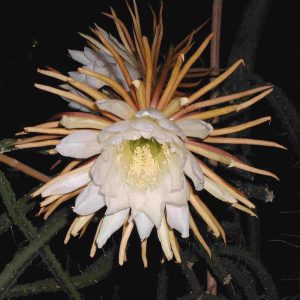Editor’s note: Cactus grandiflorus or Selenicereus grandiflorus is a cactus species originating from the Antilles, Mexico and Central America.
The species is commonly referred to as queen of the night, night-blooming cereus, large-flowered cactus, sweet-scented cactus or vanilla cactus.
In Homeopathy, Cactus grandiflorus is commonly used for heart diseases (like Valvular diseases, Congestive Heart Failure etc), asthma and headache.
In potentised homeopathic dosage, it has no reported side effects. The most commonly used potency is Cactus g 30c. It is also used in mother tincture form as a cardiac tonic.
Generalities

Circulation becomes irregular, causing violent congestion or localized pulsations, behind stomach, at odd places. It is a HAEMORRHAGIC remedy, favours formation of clots speedily. Constrictive or spasmodic pains, that extorts cries.
In Cactus, Periodicity is marked, and neuralgic pains occur periodically. Body feels tight or wrapped. Hot gushing into chest. Toxic goitre, with cardiac symptoms.
General weakness and prostration. Fainting. Dropsical affections.
Ill effects of sun, damp, disappointment in love. Many complaints are associated with heart affections. Pulseless, panting and prostration. Low blood pressure, from weakness of heart.
Better
Open air. Pressure on vertex.
Worse
Lying, on left side, on occiput. Periodically. Exertion. 10-11 a.m. or 11 p.m. Night. Walking. Going upstairs. Noise. Light. Sun heat.
Mind
Taciturn. Weeps, knows not why worse consolation. Believes that his disease is incurable. Sad. Ill humoured. Easily frightened. Cheerful. Fear; of death, of something will happen.
Head
Heavy pain, as of a load on vertex better pressure worse talking, strong light. Cactus grandiflorus has Headache worse by seeing opera; missing of meals, noise, light, periodic, compressive, pulsating. Vertigo worse deep breathing, exertion.
Eyes
Dimness of sight. Eyes blood shot. Exophthalmic goitre.
Ears
Pulsation in ears. Singing, ringing in ears.
Nose
Profuse epistaxis, but soon ceases.
Face
Right sided prosopalgia worse missing of meals. Face; red bloated, pale, emaciated.
Throat
Constriction of oesophagus, must drink to swallow. Suffocative constriction, with full throbbing carotids.
Stomach
Pulsation in coeliac artery behind the stomach. Vomiting of blood. Nausea in the morning: continuous all day. Loss of appetite. Aversion to meat of which he was fond.
Abdomen
Intense burning in abdomen. As of a weight in anus. Pricking as from a pin in anus, better slight friction. Fistula in ano, with violent palpitation of heart.
Engorgement of liver due to heart disease. Sharp pain shooting through diaphragm and up into chest. Cactus grandiflorus has a sensation as if a cord was tied tighter and tighter around attachment of diaphragm, taking his breath away.
Urinary Organs
Constriction of neck of bladder, causing retention of urine. Urine suppressed in fevers. Haematuria; urination prevented by clots, in vagina in females.
Female
Menses; lumpy; black; too soon, cease on lying. Constriction of vagina preventing coition; vaginismus. Painful menses, extorting loud cries.
Menstrual disorders, with heart symptoms. Pulsation in ovarian region. Cyanotic infants.
Respiratory organs
Oppression of breathing, going upstairs. Cough, from heart affections. Continuous rattling of mucus in chest. Constriction in chest, as if bound; hindering breathing.
Periodical suffocation; with fainting, sweat on face and loss of pulse. Haemoptysis, with convulsive cough. Inflammation of diaphragm, with difficulty in breathing.
Cactus grandiflorus Heart symptoms
FEELS CLUTCHED AND RELEASED ALTERNATELY BY AN IRON BAND BAND, or feels it expand and contract; seems to turn over. Endocarditis, with mitral insufficiency. Palpitation; worse lying on left side; at the approach of menses; during the day while walking; from disappointed love. Stitches in heart.
Endocardial murmurs. Hypertrophy. Low blood pressure. Pulse; irritable, intermittent, feeble. Irregular and intermittent action, after forceps delivery.
Heart disease, with oedema of left hand. As if heart would fly to pieces on holding the breath. Pulsations increase on holding the breath. Aneurism of large arteries and heart. Tobacco heart.
Extremities
Left arm numb. Fingers tingle. Icy cold hands. Oedema of hand (left) in heart disease; and of feet, extending to knees. Hands soft, feet enlarged. Pain in left arm down to fingers.
Sleep
Cactus grandiflorus has Sleeplessness, on account of strong pulsations in different places. Dreams; of falling; frightful; lascivious. Awakes in fright.
Fever
Chilly not worse by covering. Persistent subnormal temperature.
Cactus grandiflorus is Related to
Aconite; Coccus-cacti; Digitalis; Lachesis; Nux-vomica; Sulphur.


